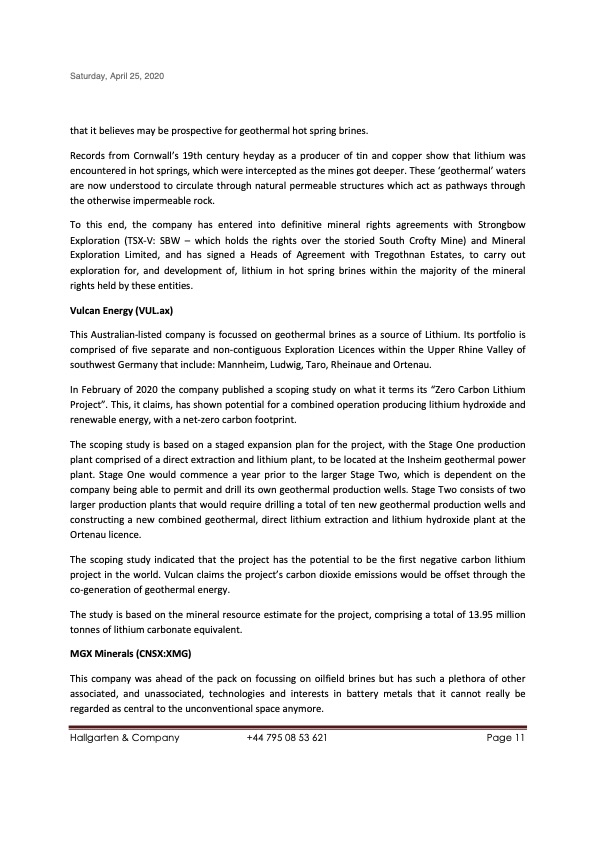
PDF Publication Title:
Text from PDF Page: 012
Saturday, April 25, 2020 that it believes may be prospective for geothermal hot spring brines. Records from Cornwall’s 19th century heyday as a producer of tin and copper show that lithium was encountered in hot springs, which were intercepted as the mines got deeper. These ‘geothermal’ waters are now understood to circulate through natural permeable structures which act as pathways through the otherwise impermeable rock. To this end, the company has entered into definitive mineral rights agreements with Strongbow Exploration (TSX-V: SBW – which holds the rights over the storied South Crofty Mine) and Mineral Exploration Limited, and has signed a Heads of Agreement with Tregothnan Estates, to carry out exploration for, and development of, lithium in hot spring brines within the majority of the mineral rights held by these entities. Vulcan Energy (VUL.ax) This Australian-listed company is focussed on geothermal brines as a source of Lithium. Its portfolio is comprised of five separate and non-contiguous Exploration Licences within the Upper Rhine Valley of southwest Germany that include: Mannheim, Ludwig, Taro, Rheinaue and Ortenau. In February of 2020 the company published a scoping study on what it terms its “Zero Carbon Lithium Project”. This, it claims, has shown potential for a combined operation producing lithium hydroxide and renewable energy, with a net-zero carbon footprint. The scoping study is based on a staged expansion plan for the project, with the Stage One production plant comprised of a direct extraction and lithium plant, to be located at the Insheim geothermal power plant. Stage One would commence a year prior to the larger Stage Two, which is dependent on the company being able to permit and drill its own geothermal production wells. Stage Two consists of two larger production plants that would require drilling a total of ten new geothermal production wells and constructing a new combined geothermal, direct lithium extraction and lithium hydroxide plant at the Ortenau licence. The scoping study indicated that the project has the potential to be the first negative carbon lithium project in the world. Vulcan claims the project’s carbon dioxide emissions would be offset through the co-generation of geothermal energy. The study is based on the mineral resource estimate for the project, comprising a total of 13.95 million tonnes of lithium carbonate equivalent. MGX Minerals (CNSX:XMG) This company was ahead of the pack on focussing on oilfield brines but has such a plethora of other associated, and unassociated, technologies and interests in battery metals that it cannot really be regarded as central to the unconventional space anymore. Hallgarten & Company +44 795 08 53 621 Page 11PDF Image | Unconventional Lithium from Brine

PDF Search Title:
Unconventional Lithium from BrineOriginal File Name Searched:
UnconventionalLithium_April2020.pdfDIY PDF Search: Google It | Yahoo | Bing
Product and Development Focus for Infinity Turbine
ORC Waste Heat Turbine and ORC System Build Plans: All turbine plans are $10,000 each. This allows you to build a system and then consider licensing for production after you have completed and tested a unit.Redox Flow Battery Technology: With the advent of the new USA tax credits for producing and selling batteries ($35/kW) we are focussing on a simple flow battery using shipping containers as the modular electrolyte storage units with tax credits up to $140,000 per system. Our main focus is on the salt battery. This battery can be used for both thermal and electrical storage applications. We call it the Cogeneration Battery or Cogen Battery. One project is converting salt (brine) based water conditioners to simultaneously produce power. In addition, there are many opportunities to extract Lithium from brine (salt lakes, groundwater, and producer water).Salt water or brine are huge sources for lithium. Most of the worlds lithium is acquired from a brine source. It's even in seawater in a low concentration. Brine is also a byproduct of huge powerplants, which can now use that as an electrolyte and a huge flow battery (which allows storage at the source).We welcome any business and equipment inquiries, as well as licensing our turbines for manufacturing.| CONTACT TEL: 608-238-6001 Email: greg@infinityturbine.com | RSS | AMP |